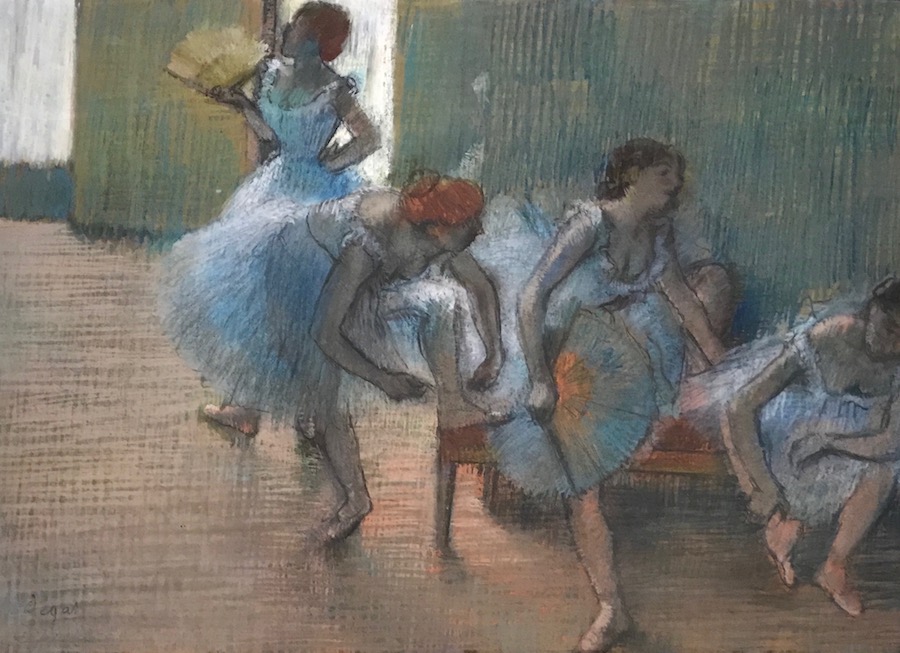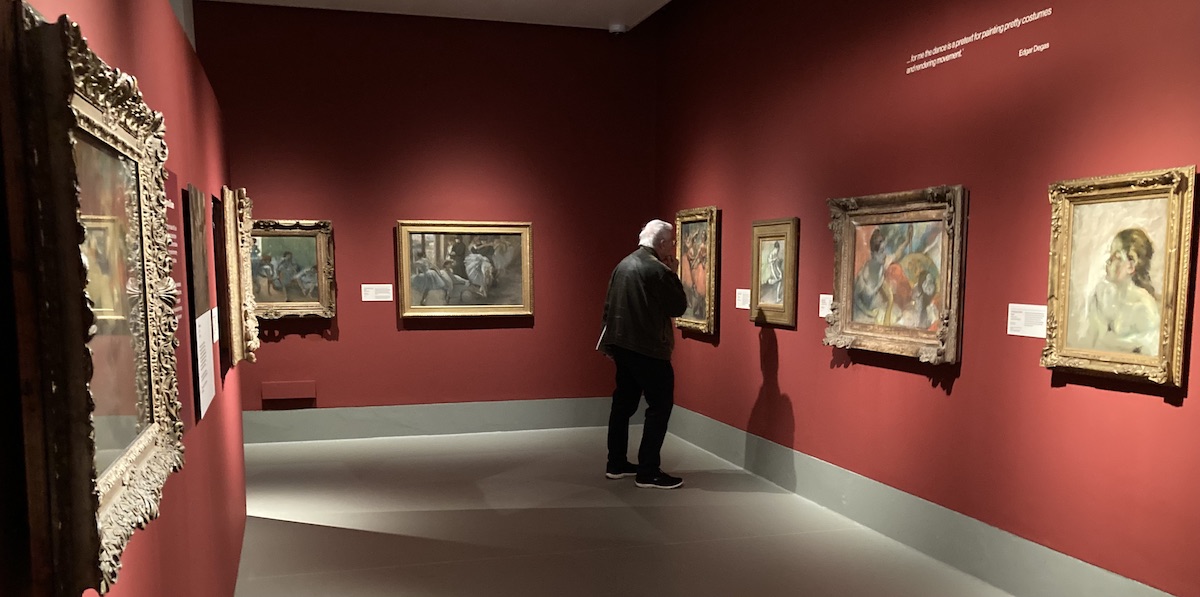I have been critical of Burrell since its recent £68m makeover, terrible labelling, and overly complicated IT presentations. However, I was blown away by their new Degas show! Fifty works, half bought by Burrell and half loans, are beautifully installed in the new basement exhibition space. Curators Francis Fowle, chair of trustees, and Pippa Stephenson-Sit from Glasgow Museums have done a very good job. Even the shop looks nicer than usual!
Burrell’s collection contains a wonderful, comprehensive selection of Degas subjects – the ballet, horseracing, laundresses, bathers, and portraiture in oil, pastel and bronze. The loans are equally varied and include his famous 1875 masterpiece ‘L’Absinthe’, all the way from Paris. This was hissed at during an 1892 auction, then bought and sold, a rollercoaster of returns, and now belongs to the Musée d’Orsay. The catalogue goes into great detail on all the exhibits, including fascinating comments on collectors, sales and prices.
This show marks the centennial anniversary of the famous first Impressionist Exhibition. However, in Paris, not all Degas works were well received, so the artist looked to Britain for a more receptive audience. He first visited London in 1871. Over the years he showed with several UK art dealers and by 1891 was with Glasgow dealer Alex Reid.

Burrell first saw Degas’s work at the 1888 International Exhibition in Glasgow. Over the next 40 years, he acquired over 20 Degas pictures, far more than any other British collector. From 1889 on, the astute Reid was key in encouraging a taste for Degas. Soon, Burrell was hooked, and Reid was selling so well that he earned the sobriquet “Degas Reid”! While Reid saw Degas often, sadly, Burrell never met him, a fact he often regretted.
Burrell was not alone in his compulsive buying. Competition among industrialist collectors was fierce! Degas’ pictures were never cheap. At £1000 back in the 1920s, they were mainly bought by the rich, like Gulbenkian, Sir Peter Coats, or David Cargill, whose father founded the Burma oil company and who bought the marvellous’ Jockeys Before the Race’ from Reid in 1922. Textile businessman Arthur Kay bought ‘In the Cafe’ in 1891 and took his picture home to Glasgow’s Kelvinside. Burrell took his home to 8 Great Western Terrace, just round the corner from me, which he bought in 1901. Other Glasgow industrialists like ship owners Leonard Gow and William McInnis acquired pastels of ballet dancers from Reid, and so did Aberdeen collector Sir James Murray, who made his fortune in the beef industry.
Not all Scottish collectors were men. The 1879 picture of Diego Martelli, an Italian art critic in Degas’ circle in Paris, was acquired by Elizabeth Workman from Helensburgh, wife of shipbuilder Robert Workman. She hung it in the billiard room of their stylish Mayfair apartment.
After Degas died in 1917, the director of London’s National Gallery observed, “His works will probably never be quite so cheap again, and he is a great artist whom we shall inevitably have to buy someday.” But much of Degas’s work was wildly experimental, and the Scottish National Gallery was slow to acquire it.
The first solo Degas exhibition in the UK took place in London in 1922, with low prices for pastels, a few hundred pounds. One oil went to the industrialist Samuel Courtauld. In 1924, 72 works were shown at Reid’s Glasgow gallery. A selection of bronzes of horses walking, trotting and galloping sold well. The exhibition was a revelation and prompted the Scottish National Galleries to purchase their first work – a bronze version of the little dancer, age 14. Only once Stanley Cursiter became director in 1930 did things improve.
In 1952, the Edinburgh Festival organised a major Degas exhibition at the RSA, which went on to the Tate and became legendary.
Burrell was always keen to make his works widely available to the public, be they in Dundee, Berwick-on-Tweed, or London’s Tate. He showed his pictures at the Royal Glasgow Institute and also at the RSA in Edinburgh. He was insistent that Glasgow receive all his Degas works.
One of Burrell’s last acquisitions is the memorable “Jockeys in the Rain”, 1884. Purchased in 1937 and previously owned by Gow, it’s a rare image, the only one with rain! Degas was an incredible draughtsman who always put drawing first. Fowle says, “He liked to paint people moving, as in the ballet, racehorses, women at work, and I think Burrell really appreciated that love of drawing.”
Burrell gave his collection to Glasgow in 1944 – 8000 objects collected over many years. By then, the prices of Impressionist art had gone beyond the reach of all but the very wealthy. Degas paintings were selling for millions, but Burrell had already amassed more Degas works than any other individual. Lucky Glasgow!
Discovering Degas: Collecting in the Time of William Burrell, Burrell Collection, Glasgow 24 May-30 September 2024,
Visit Here
Photos ©Artlyst 2024

